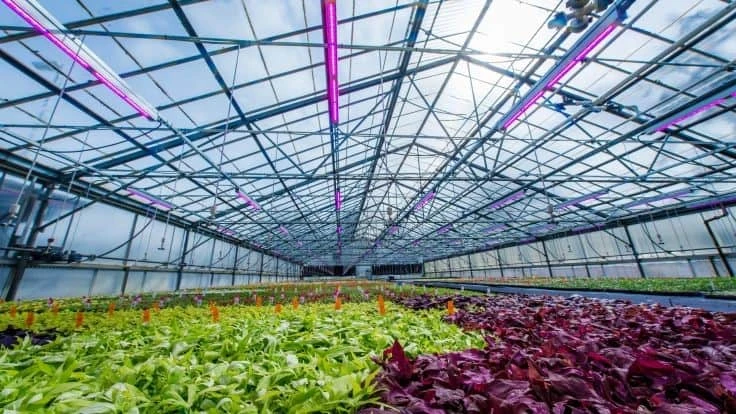
Image Courtesy of Philips
Commercial greenhouse operations are trading in and trading up from traditional high-pressure sodium (HPS) supplemental lamps to newer, more efficient LED grow lights.
In a general sense, both HPS and LED light fixtures provide supplemental light to increase growth. However, when growing under LEDs, there are several aspects of your lighting strategy to consider to ensure that you are maximizing all the benefits offered by LED grow lights.

On a global team of plant specialists at Signify supporting the Philips horticulture LED team, Colin Brice advises growers through the transition in cultivating under LEDs. He provides a lighting application “playbook” based on the specific crop(s), cultivation methods, and the facility’s operational objectives.
Brice says there are a few factors growers need to consider when switching to LEDs:
- Crop temperatures. HPS fixtures overall tend to run quite a bit hotter than LEDs so that means switching to LEDs will also entail adjusting your greenhouse heating and cooling. “The general rule of thumb is that for every 50 micromoles per meter square of light converted from HPS to LED, the crop will be two to four degrees cooler (Fahrenheit) since there is a significant loss of radiant heat to the crop,” Brice explains. “Even if your light levels remain the same with the LEDs you’ve installed, the plant can’t convert all the light into growth unless the plant remains at the same temperature experienced under HPS.”
- Irrigation and fertility rates. If temperature cannot be supplemented when changing from HPS to LED, to ensure crops maintain similar transpiration and evaporation rates, then rates of irrigation and fertility may need to be adjusted. Changing to LEDs most likely will cause a drop in the crop temperature, therefore, substrates won’t dry out as fast and that means less watering. Brice advises, “growers want to avoid potential nutrient deficiencies, especially in the case of phosphorus, so phosphorus concentrations may need to increase to cover for less frequent watering.”
- Overall lighting strategy. The team at Signify incorporates local weather and solar radiation data to “recommend light intensity, optimal light spectrum, and calculate over the grow season how many LED lighting hours per day they’ll need to grow a quality crop.” Brice says this will change “in terms of making sure that we’re lighting for the correct number of hours to achieve optimal daily light integrals (DLI), and not exceed the recommended maximum (hours) for the crop.”
With the improvements made in LED technology over the past few years, in efficiency and efficacy, and the fact that the spectral composition of LEDs is optimized for horticulture applications, there is really no reason to not consider LEDs.
When you begin the process of converting from HPS, whether this year or next, the information above will hopefully make your transition easier. And if you decide to go with Philips LED grow lights, you can be certain you will have a solid team of experienced and knowledgeable horticulture professionals to lean on for advice and recommendations.
“There are a lot of cultivation issues that can be easily overlooked or not fully taken advantage of,” Brice says. “Our plant specialist team is not necessarily here to tell the growers exactly how they should use the light, and many of them honestly don’t need us to tell them that. We’re here to make sure they have every single tool at their disposal to make the right decisions for the production goals when it comes to lighting.”
Latest from Greenhouse Management
- Anthura acquires Bromelia assets from Corn. Bak in Netherlands
- Top 10 stories for National Poinsettia Day
- Langendoen Mechanical hosts open house to showcase new greenhouse build
- Conor Foy joins EHR's national sales team
- Pantone announces its 2026 Color of the Year
- Syngenta granted federal registration for Trefinti nematicide/fungicide in ornamental market
- A legacy of influence
- HILA 2025 video highlights: John Gaydos of Proven Winners





